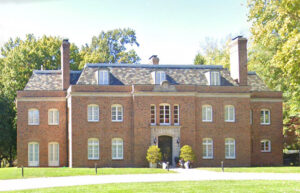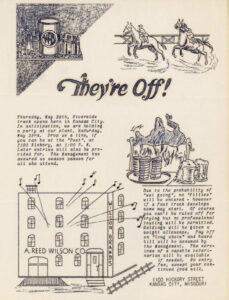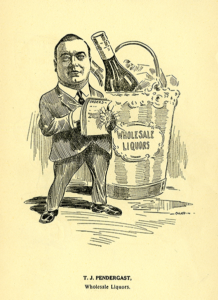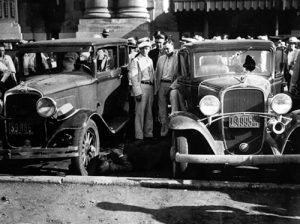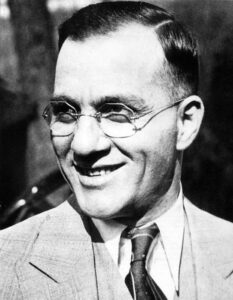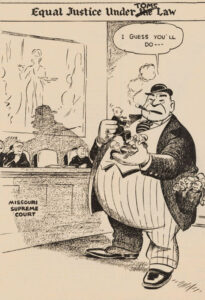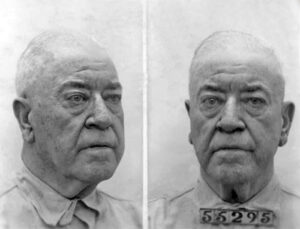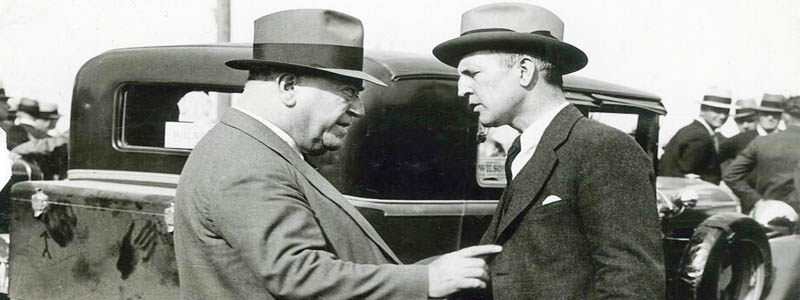
Tom Pendergast, Leader of the Democrat Machine
Between 1890 and 1940, the Pendergast Era was ruled by Democratic big city bosses James and Tom Pendergast.
By the early 20th century, this political Machine would loom large over Kansas City, Missouri. In the following years, it would dominate the police department, courts, politics, and businesses. At the same time, it turned a blind eye to gambling, bootlegging, embezzlement, election fraud, bribes, and prostitution, creating a “wide-open” town.
Political bosses and their “machine organizations” operated in large cities at the turn of the century, enjoying strong support among the poor and immigrants. The political boss represented a source of patronage and jobs, and the people saw bosses and political machines as a means to greater enfranchisement.
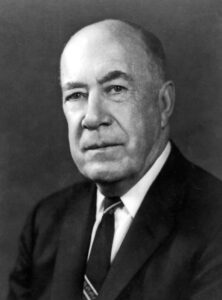
James Pendergast
In 1876, James Pendergast, the oldest son of Irish immigrants, moved from St. Joseph, Missouri, to Kansas City’s West Bottoms. He initially worked in a packing house before moving to a local iron foundry. He then established the Climax Saloon with money he won from betting on a longshot horse at a local race track. In 1880, he opened a boarding house at 1320-1322 St. Louis Avenue called the Old American House, which he ran the boarding house for 31 years.
Pendergast began networking with local leaders from his newly opened bar and soon built a powerful faction in the Jackson County Democratic Party. His faction was called the “Goats” because they were backed by those living in the hills above the river.
In 1884, he was elected to represent the sixth ward at the Democratic Cities Convention. In 1887, he became the Democratic committeeman for the first ward. He was elected alderman in 1892. Known as “Alderman Jim” and “Big Jim,” he achieved political power by doing favors.
James summoned his younger brother Thomas from nearby St. Joseph to help him at that time. Tom worked at Jame’s Climax Saloon in the West Bottoms area at the bottom of the bluffs overlooking the Missouri River. James tutored Tom in the diversities of the city’s politics and systems and the strategic advantages of controlling blocs of voters.
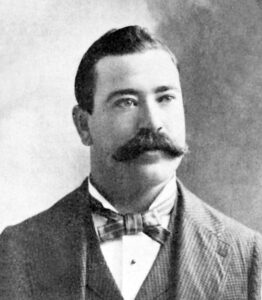
Thomas J. Pendergast
“Big Jim” then won his first of nine city council terms. However, James’ health deteriorated in the following years, and he retired in 1910 and died the following year after naming Tom his successor. “Boss” Tom Pendergast assumed leadership of the local Democratic political Machine and used many of his brother’s connections to lead the “Goat” faction. He led his group in bitter competition against rival machine bosses, especially Joe Shannon, leader of the “Rabbits,” called such because their power base was at the river bottom.
After his brother’s death, Tom Pendergast served on the city council until he stepped down in 1915 to focus on his un-elected role as leader of the Jackson Democratic Club, the formal party organization of the Pendergast Machine. From his office, he worked to ensure the election of favorable candidates to city positions, from which they could award lucrative contracts to Pendergast-owned or affiliated businesses or extend patronage — chiefly in the form of jobs — to individual machine supporters.
In 1919, when Prohibition was imposed on the nation, Kansas City remained unaffected, primarily due to the Pendergast Machine. Pendergast’s Machine bribed the police force, city leaders, and Kansas City’s federal prosecutor. This ensured gambling and bars remained open, and liquor was supplied.
“If you want to see some sin, forget about Paris. Go to Kansas City.”
— George Miller, the editor of the Omaha Herald
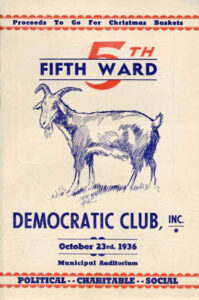
Pendergast 5th Ward Democratic Club
With the wide-open access to alcohol and gambling, entertainment and culture was cultivated and thrived. It played a significant role in the birth of Kansas City Jazz, born in the African American community at 18th & Vine Streets. While jazz began in the 1920s with a bang, it flourished in the 1930s, mainly due to political boss Tom Pendergast. Famous jazz musicians included bandleader Bennie Moten and saxophonist Charlie Parker. Jazz remains popular in clubs, events, and dozens of nightclubs.
By 1925, Pendergast had little serious competition as rival bosses and their organizations were integrated into the larger Pendergast Machine, displaced completely, or bought off.
By 1926, the Pendergast faction had co-opted its last rivals — Joe Shannon’s “Rabbits” and Cas Welch’s East Side group that included African American precincts. This provided much more stability for the Machine in the future.
Pendergast gained control of the city government the same year when his right-hand man, Henry McElroy, became the city manager. McElroy would hold the position until 1939.
In 1927, Pendergast established an office for his Machine in a building that still stands at 1908 Main Street.
In 1928 Tom moved his family to a new mansion at 5650 Ward Parkway. Designed by J.C. Nichols Company architect Edward Tanner, the French Provincial home featured six bedrooms and five baths. The Pendergast family lived in the home from the time of completion until Tom Pendergast died in 1945.
The same year, Pendergast and others formed the Riverside Park Jockey Club, which operated the Riverside Park horse track in Platte County. He also purchased a farm in Clay County, which he outfitted as a stud horse breeding facility. While potentially profitable for investors, the track was not profitable for Boss Tom. By then, he had developed an insatiable desire to bet on the ponies. Several years later, in 1935, a gambling publication quoted in The Kansas City Investigation stated that from mid-August to mid-September 1935, Pendergast had wagered over $2,000,000 and had “gone overboard,” or lost $600,000. Pendergast would not recoup his losses, as Anti-gambling forces were able to shut down the track in 1937.
1929 the Great Depression began, making unemployed people more dependent on anyone who could provide a wage-paying job. Pendergast and McElroy worked on a prodigious bond issue known as the Ten-Year Plan during this time. The plan called for city improvements, including roads, sewer systems, waterworks, parks, police and fire fighting equipment, street signs, and pedestrian walkways, creating thousands of jobs.
Voters approved the $32 million bond package by a four-to-one margin on April 17, 1931. In the following years, Kansas City expanded while other cities were suffering through the Great Depression. Significant construction projects included the 29-story City Hall, the former Jackson County Courthouse, the Fidelity Bank and Trust, Police Headquarters, and Municipal Auditorium. During this time, taxes were half the amount of comparable cities.
While Kansas City was building, the bond revenues became a source of significant floating funds that passed through the City Manager’s “Emergency Fund” to be used with little discretion or oversight. Shifting money became even more accessible as President Franklin D. Roosevelt’s New Deal programs were implemented in 1933. When the Public Works Administration and the Works Progress Administration took over much of the actual construction of facilities, shifting funds paid hundreds of machine-controlled employees who never did anything but pick up their paychecks, with the rest of the funds turned over to the Pendergast’s bookkeeper, Ernest L. Schneider.
In the meantime, Boss Tom also was involved in many other endeavors not directly related to politics. Tom owned nearly half of the company’s shares of the Sanitary Service Company, which was the city’s sole refuse collector. Tom’s other businesses included the T. J. Pendergast Wholesale Liquor Co., Atlas Beverage Co., City Beverage Co., the sole distributor of Anheuser-Busch products in Kansas City, W. A. Ross Construction Co., and dozens of others. Businesses not directly associated with Pendergast routinely had to pay the Machine as much as five or ten percent of gross revenue to do business in Kansas City without harassment from police or city regulators.
In the 1930s, gambling expanded into department stores, drug stores, and mom-and-pop grocery stores with the adoption of slot machines.
Pendergast’s power peaked in 1932 when Kansas City controlled its police department that had previously been under the direction of a governor-appointed Board of Police Commissioners. This ultimately gave Pendergast and the Machine more free rein, along with a sense of invulnerability. However, it may have caused Boss Tom to become overconfident and decrease his judgment on more questionable political and governing activities.
The third element of the crime trifecta at the time was prostitution. Speakeasies, jazz clubs, and public gathering places attract prostitutes, politicians, and businessmen. They, or their representatives, had to pay regular amounts to the enforcers to stay out in the open where they could solicit business. If those who plied these trades did not make the expected payments, the McElroy-controlled police could step in to shut down the illegal side of any of these enterprises.
When Prohibition was finally repealed in 1933, very little changed in Kansas City.
On June 17, 1933, the Union Station Massacre occurred when an attempt was made to free a federal prisoner being taken to Leavenworth Penitentiary. When three gangsters attempted to free Frank Nash from FBI custody, they killed him, three police officers, and an FBI agent. The gangsters had spent the prior evening at the Hotel Monroe, adjacent to Tom Pendergast’s office. They had received assistance in eluding a bribed police force from John Lazia, a prominent underworld figure with connections to Pendergast. Pendergast ally Johnny Lazia was later implicated in planning the escape attempt. One shooter has been positively identified as a mobster named Vernon Miller, who was only charged with obstruction of justice. The other shooters were never fully identified, although the FBI settled on Charles “Pretty Boy” Floyd and Adam Richetti as the fall guys. Within a year, all three were dead.
The tremendous public outrage over the shootout convinced the Pendergast Machine that Lazia had become a liability that needed to be eliminated. In early 1934, without Tom’s protection, Lazia was indicted for bootlegging, illegal gambling, and tax evasion. Lazia eventually pleaded guilty to tax evasion and was sentenced to one year in prison. However, Tom Pendergast got Lazia free on bail during the appeal. On the night of July 9, 1934, as Lazia was returning from his collection efforts with his wife Marie beside him and his driver Charley Carrollo, he was gunned down at the entrance to Park Central. Though Carrollo successfully whisked away Lazia’s wife, Lazia died a few hours later.
To those watching, these events indicated that Pendergafts control and effectiveness were waning.
Later that year, at the 1934 city election, there were shootings, intimidation, and extensive voter fraud, and four people were killed. Known as the “Bloody Election,” it drew the attention of Federal Judge Albert Reeves, who convened grand juries to investigate. Over the next four years, these grand juries indicted hundreds of machine operatives on charges ranging from ghost voting to outright voter intimidation. However, not one of the convicted persons would “roll over” on the higher-ups in the Machine.
In 1936, Tom was attending the Democratic National Convention in Philadelphia, Pennsylvania, when he suffered a severe heart attack. On follow-up, it was discovered that he had colon cancer requiring surgery. Afterward, his health declined overall.
The same year, a routine IRS inspection of the accounts of a now-dead partner of a legal firm turned up receipts of checks totaling $100,500 received from several insurance companies. This accidental discovery set an investigation in motion. When it was completed in 1939, Pendergast was prosecuted for failing to pay taxes on a bribe received to pay off gambling debts. Pendergast served one year of his 15-month term at the U.S. Penitentiary in Leavenworth, Kansas. He was then released with five-year parole for good behavior with a requirement not to engage in politics. He also was required to pay $430,000 in back taxes, penalties, and interest and a $10,000 court fine. Afterward, he lived quietly at his home on Ward Parkway.
The “Clean Sweep” campaign of 1940, organized by the Citizens League of Kansas City and the United Campaign, resulted in the near complete ouster of Pendergast affiliates from public office, a new mayor, city council, and city manager. Chief of Police Otto P. Higgins went to prison for income tax evasion, about half of the city’s police officers were fired, and the police department was placed under the authority of a state board appointed by the governor.
Tom Pendergast never recovered his health and died from a heart attack on January 26, 1945. He was buried at Calvary Cemetery in Kansas City.
Between 1925 and 1939, Boss Tom freely ruled Kansas City without worrying about consequences or penalties. Corruption flourished because, in many other respects, Kansas City was enjoying the fruits of a golden age. Its central location in the continental United States enabled extensive railroad connections, the second-busiest stockyards in the world after Chicago, a world-class garment industry, several national conventions, and a rapidly growing population. During this time, the Kansas City boulevard and park system was developed; the Country Club Plaza and Country Club District was created; the University of Missouri-Kansas City, Kansas City Art Institute, Nelson-Atkins Museum of Art, and the Liberty Memorial were established; TWA made Kansas City the hub of national aviation; most of the downtown Kansas City buildings were built; its inner-city culture blossomed with contributions to Negro League baseball, Kansas City jazz music, and Kansas City-style barbecue.
©Kathy Alexander/Legends of America, June 2023.
Also See:
Sources:
American Association for State and Local History
Historic Kansas City
Missouri Valley Special Collections
Pendergast KC
Virginia Commonwealth University
Wikipedia – James Pendergast
Wikipedia – Tom Pendergast

